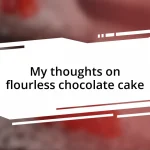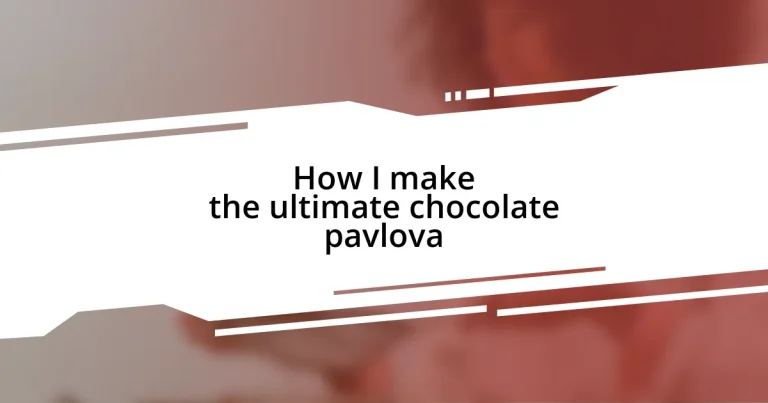Key takeaways:
- Key ingredients for chocolate pavlova are egg whites, caster sugar, and cocoa powder for a rich flavor and smooth texture.
- Whipping egg whites requires clean equipment and gradual sugar addition to achieve stiff peaks and a glossy meringue.
- Bake at a low temperature (around 250°F/120°C) and allow cooling in the oven to prevent cracks.
- For assembly, use freshly whipped cream and fresh fruits for decoration, ensuring the meringue and toppings are stored separately to maintain crispness.
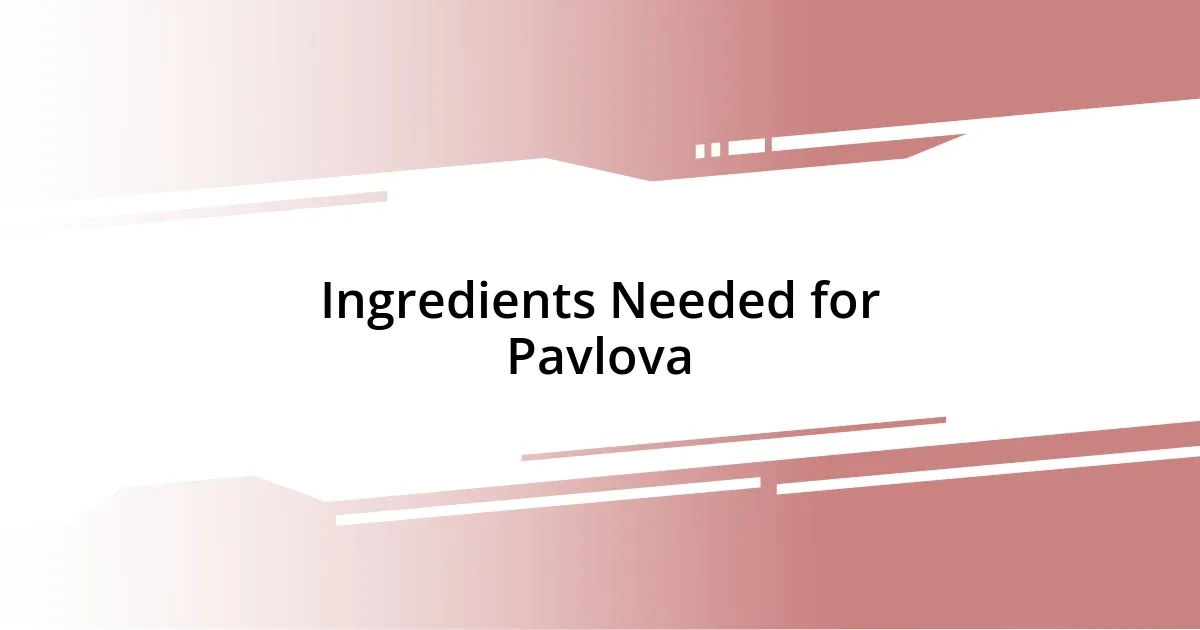
Ingredients Needed for Pavlova
When it comes to making the ultimate chocolate pavlova, the star ingredient is, without a doubt, egg whites. It’s fascinating how something so simple can transform into a cloud-like creation. I still remember the first time I whipped up those egg whites and saw them turn glossy and stiff—such a satisfying moment in the kitchen!
You’ll also need caster sugar, which helps create that perfect crisp crust. I prefer using caster sugar because it dissolves easily, ensuring a smooth texture. Have you ever tasted a pavlova with gritty sugar? Trust me; it’s not a pleasant experience. I learned this the hard way during my early baking days, and now I can never go back!
Don’t forget about the cocoa powder; it’s what gives this pavlova its rich chocolatey flavor. I find myself savoring the aroma of the cocoa as I mix it into the meringue—it’s just heavenly! This balance of ingredients not only enhances the taste but also creates that beautiful contrast when topped with fresh whipped cream and berries. What’s your favorite part about making desserts like this? For me, it’s the moment you take it out of the oven and see that gorgeous, puffy masterpiece!
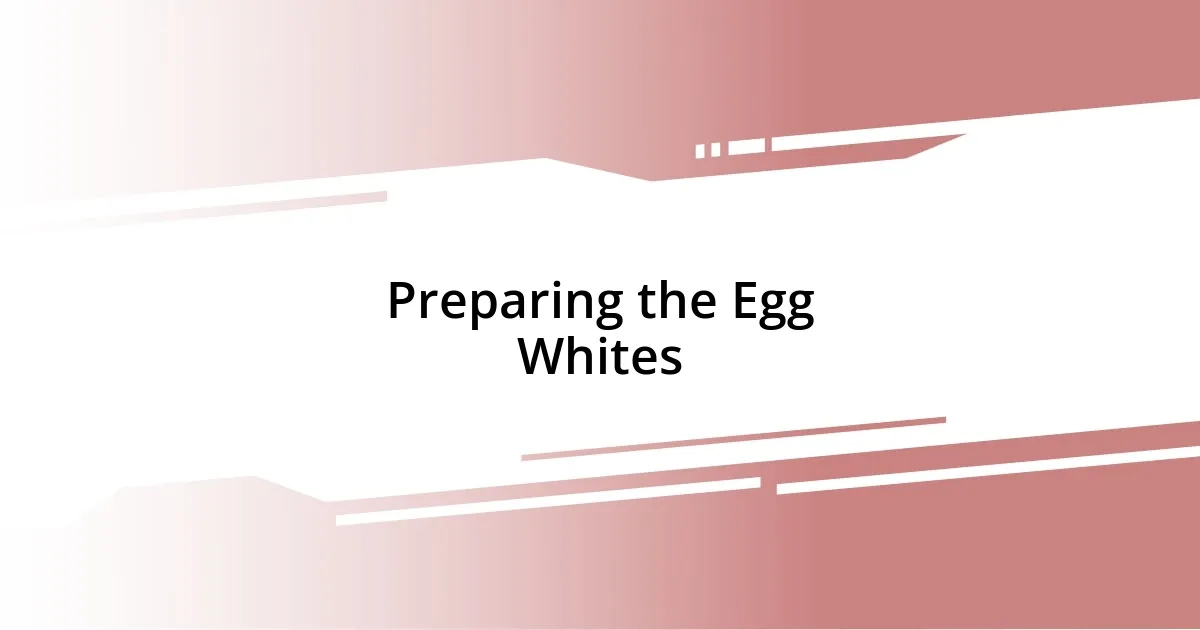
Preparing the Egg Whites
Whipping egg whites is an art form that requires a bit of finesse and attention. I always make sure my mixing bowl and whisk are incredibly clean. Even a tiny speck of fat can prevent the egg whites from achieving that coveted volume. The first time I realized this, I ended up with a flat meringue instead of the tall and proud pavlova I’d envisioned. Such a letdown!
As you start whipping the egg whites, you’ll want to do it on a low speed at first. Gradually increasing the speed gives better control and results in a lovely glossy texture. I find myself watching the egg whites transform, which is almost magical. You’ll know it’s time to add the sugar once soft peaks form—this is when the fun really begins! It’s like a dance, pouring in the sugar slowly while the mixer does its work.
When the mixture reaches stiff peaks, it’s an unmistakable moment of triumph! I remember one particularly successful batch where the egg whites turned a shining white, reflecting light like freshly fallen snow. At that moment, I couldn’t help but feel a rush of excitement. Get ready to fold in that cocoa powder afterward, but take it easy—overmixing will deflate that beautiful volume you’ve worked so hard for. Trust me; the delicate balance is key!
| Step | Tips |
|---|---|
| Ensure Clean Equipment | Use a clean bowl and whisk to avoid fat contamination |
| Whip Gradually | Begin at low speed, increasing to medium for control |
| Check Peak Stiffness | Add sugar when soft peaks form, whip to stiff peaks |

Achieving Perfect Meringue Texture
Achieving that perfect meringue texture is truly a journey worth taking. I vividly remember the first time I experimented with the slow addition of sugar—it was like watching my dreams come to life right in front of me! As the mixture transformed, I realized how crucial timing and technique are in this delicate process. If you rush it, you could end up with a meringue that lacks that ethereal quality we all crave.
To ensure you get that perfect texture every time, keep these tips in mind:
- Temperature Matters: Make sure your egg whites are at room temperature; they whip up better than cold ones.
- Add Sugar Gradually: Introduce the sugar slowly, a tablespoon at a time, to achieve a beautiful shine and stability.
- Test for Gloss: Look for a glossy appearance; if it looks dull, it may need more whipping!
- Avoid Humidity: Meringue loves a dry environment, so avoid making it on humid days if possible.
- Use a Silicone Spatula: When folding in the cocoa powder, a gentle touch with a silicone spatula preserves volume superbly.
In doing meringues over the years, I’ve learned that taking these extra steps creates a texture that’s not just light but truly magical. The first time I really nailed it, I pulled my pavlova from the oven, and it felt like my entire baking journey had led to that moment. Who knew a pile of egg whites could bring such joy?
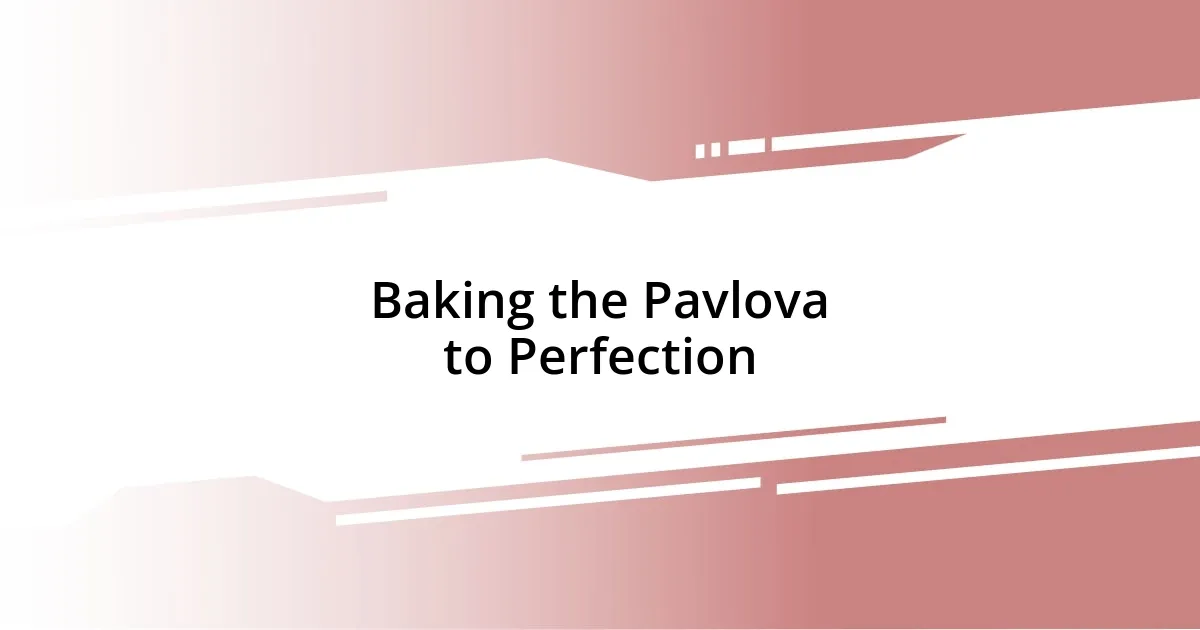
Baking the Pavlova to Perfection
When it comes to baking pavlova, timing is crucial. Once I’ve piped the meringue onto the baking sheet, I always take a deep breath and remind myself of the importance of low and slow. This isn’t a dish you can rush! The oven should be set to a low temperature, usually around 250°F (120°C), which allows the pavlova to dry rather than cook quickly. I recall one time when I cranked up the heat thinking it would speed things along; it resulted in a chewy disaster that left me frustrated. The patience pays off, I assure you!
As the pavlova bakes, resist the urge to peek too often. I know it’s tempting to look in, especially when it starts transforming into that beautiful white cloud. However, each time the oven door opens, the temperature can drop, which hinders that glorious rise we all want. I usually find something else to occupy my time, like prepping the toppings. It keeps me busy and helps prevent heart-wrenching moments of regret over a deflated pavlova.
Once the baking time is up—typically around an hour but sometimes longer depending on your oven—it’s essential to let it cool in the oven with the door ajar. This step ensures that gradual cooling doesn’t lead to cracks. I remember the feeling of pulling my first pavlova from the oven, carefully leaving the door open and watching it settle. It felt like unveiling a masterpiece, and I’d be lying if I said I didn’t feel a little proud of myself in that moment! So, trust the process, let it cool gently, and get ready for the joy of assembling your perfect pavlova!

Making the Chocolate Topping
When it comes to the chocolate topping, I find that simplicity is key. I usually start with high-quality dark chocolate—something that truly elevates the dessert. One time, I splurged on a bar from a local chocolatier, and the flavor difference was astonishing! Melting it gently in a double boiler ensures a smooth and glossy finish. Have you ever experienced that moment when the chocolate melts perfectly? It’s like magic; the aroma alone is enough to make anyone’s mouth water.
Once the chocolate is melted, I like to mix in some heavy cream. The ratio is crucial; too much cream and it turns into ganache rather than a rich drizzle. I remember the first time I went a little overboard with the cream. It created a lovely sauce, but I was left longing for that thick, luscious topping I had envisioned. Stirring the cream into the chocolate until it’s well combined adds a beautiful sheen that’s hard to resist. My advice? Don’t rush this step—patience truly pays off here!
Finally, I pour the luscious chocolate sauce over the pavlova, letting it cascade down the sides. There’s something deeply satisfying about watching the chocolate flow. It’s almost as if the pavlova is eagerly awaiting its glorious finish! I often find myself standing back, admiring the transformation, and thinking about how this simple topping turns the whole dish into a work of art. Are you ready to unleash that chocolate goodness? Believe me, your friends and family will be in for a treat!
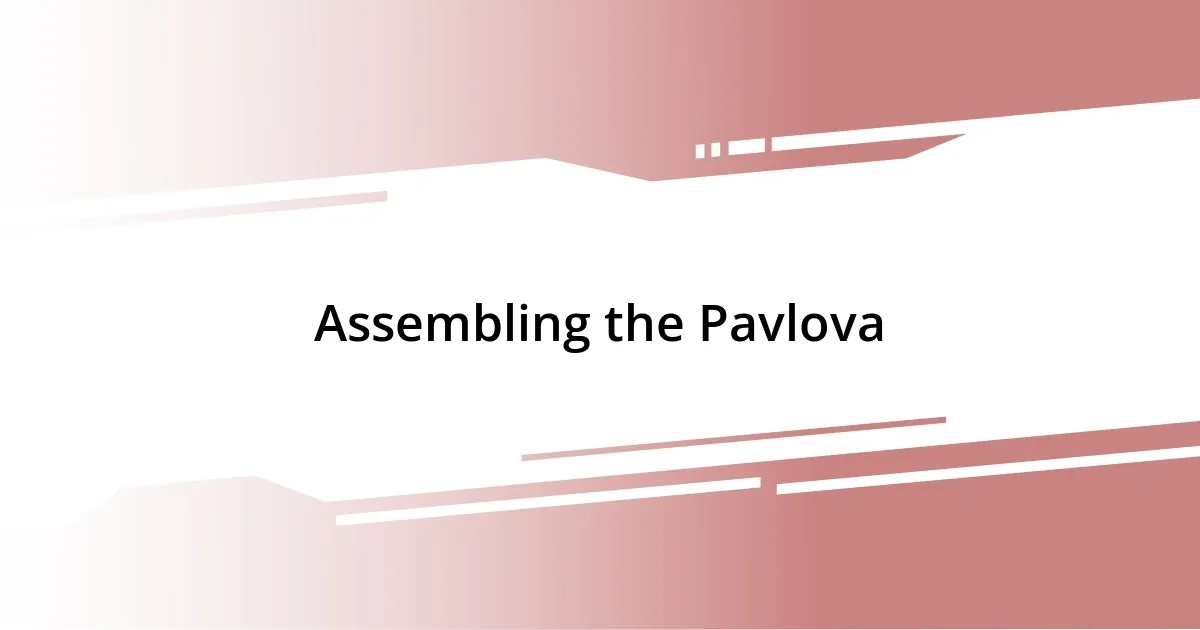
Assembling the Pavlova
As I prepare to assemble the pavlova, the excitement builds—it feels like I’m about to enter a sacred part of the baking process. Gently, I transfer the cooled meringue base to my serving platter, taking a moment to appreciate its delicate texture and crisp outer shell. Do you remember that first time you realized how fulfilling it is to treat food as a canvas? That’s exactly how I feel now.
Next comes the fun part: layering the toppings. I like to start with a generous spread of whipped cream, and I can still hear my friends raving about that rich, fluffy cloud resting on top. It’s essential to use freshly whipped cream, bringing it to soft peaks so that it holds its shape, yet feels indulgent. I often think back to the time I tried pre-packaged whipped cream in a pinch—it was just not the same! The homemade version adds that special touch that makes everything feel more heartfelt.
Finally, I top it with fresh fruits, often opting for a mix of berries to bring in some vibrant color and tartness. Watching the colors contrast against the white meringue brings such joy—it’s like decorating a cake, but more whimsical! I remember one gathering when I went a bit overboard, layering every kind of berry I could find; it looked like a colorful masterpiece straight out of a baking magazine. As I stand back to admire my work, I can’t help but smile, thinking: isn’t life about these beautiful moments, shared over dessert?
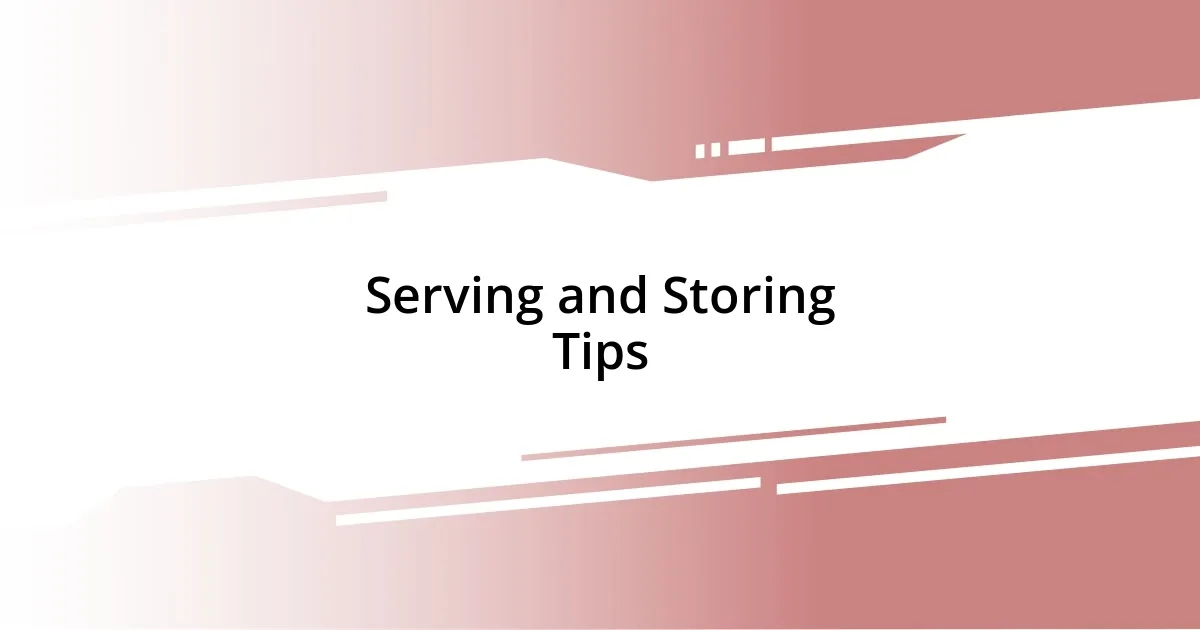
Serving and Storing Tips
When it comes to serving chocolate pavlova, presentation is everything. I often use a beautiful cake stand to elevate it, literally and figuratively. One time, I plated a pavlova on a simple white plate, and it looked lovely, but once I switched it to a crystal stand, it felt like I had taken it to the next level. Have you ever noticed how the right dish can transform your dessert? It really does make a difference!
As for storage, I always recommend keeping the pavlova separate from the toppings until it’s time to serve. I learned this lesson the hard way when my beautiful meringue turned soggy after a night of being layered with cream. Storing the meringue in an airtight container at room temperature works best, while any leftover toppings should go in the fridge. This way, you can enjoy the pavlova’s delightful crispness alongside the fresh toppings the next day.
If you find yourself with leftovers, try to consume it within a day or two. The meringue’s texture is best when fresh, as it tends to lose its signature crunch over time. I remember a dinner party where we had so much pavlova left that I thought we’d never finish it, yet we demolished it that very night! It’s a testament to how irresistible this dessert can be. What’s your favorite way to savor pavlova, even when it’s a bit past its prime?








